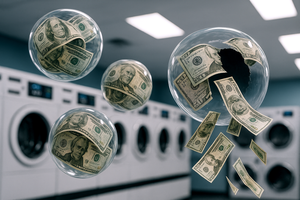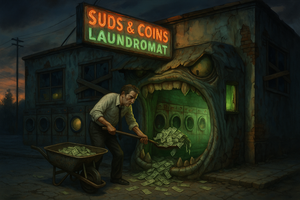Where Laundry Owners Shape Their Businesses for Tomorrow
Limited Seats. Unlimited Opportunity.
Join the exclusive circle of laundry industry owners/operators driving real change. This isn't a conference, it's the strategic advantage successful owners/operators don't skip.
✓ Elite Access - Connect with peers driving breakthrough results
✓ Proven Results - Access proven strategies from top performers
✓ For Owners/Operators - Carefully curated empowering content and speakers
"Finally, a detailed event designed for Laundry Owners by Laundry Owners."
— Multi-Store Owner/Operator
Reserve your seat today.
Limited capacity for this gathering.
I've been scrolling through laundromat for sale listings, and something caught my attention that’s concerning.
In Baltimore County, Maryland, there's a laundromat listed for $700,000 cash (or $1.3 million with seller financing). The listing boasts about 42 washers, 26 dryers, and 4,000 square feet of space. What it doesn't mention? Any income information whatsoever.
That's not an oversight. That's a symptom of a much bigger problem.
When Line Items Move Against You
While brokers showcase shiny equipment counts and square footage, the economic fundamentals of our industry have shifted dramatically. Major cost has increased:
Equipment costs have risen. Laundry equipment saw a staggering 19.29% price increase in 2021, the largest spike on record¹. Supply chain disruptions continue to get mentioned as a driver of delays and cost increases in the commercial laundry market².
Gas costs are hurting operations. California owners have mentioned dramatic increases in their gas bills. SoCalGas procurement rates are 40.1% higher compared to June 2024³. Residential customers have seen increases of about $7.93 or 12% compared to January 2025 bills⁴. Some California customers report bills that "more than doubled this winter"⁵, with average monthly increases hitting 13.2% in 2024⁶.
Labor costs keep climbing. While the federal minimum wage is at $7.25, cities across the country are putting in place $18-19 per hour minimums⁷. San Francisco hit $18.67, Mountain View $19.20, Santa Clara $18.20⁷. Even where minimums are lower, total salary costs have gone 3.6% over the past year⁸.
Commercial rents won’t stop increasing. Rent prices are 35.8% higher than before the pandemic⁹. Median rents for 2025 are projected to be 4.8% higher nationally than 2024¹⁰.
When the Numbers Don't Add Up
Let's go back to that Baltimore County listing asking $700,000 cash. According to industry data, washers earn $800-1,200 per month, while dryers typically generate 30-40% of washer revenue¹³. With 42 washers and 26 dryers, this store might generate $480,000-750,000 in gross revenue annually.
But here's where reality kicks in:
With today's cost, gas bills that have "more than doubled" in some areas, labor costs up 3.6%, and rents climbing 4.8% annually. Operating expenses could easily consume 60-70% of gross revenue. That leaves roughly $150,000-250,000 in income.
That's a 21-36% return on a $700,000 cash investment. Before taxes. Before any debt service if you take the financing option.
In a market where top money market accounts are paying over 4% ¹⁴, does a 21-36% return before debt and taxes make it worth the, time, and risk of running a laundromat?
Thinking about the thinking of laundry:
When an industry's growth depends more on new entries than operational excellence, you're not looking at a sustainable business model.
When Asking Prices, Ignore Economics
The Baltimore County example isn't unique. Scroll through business broker sites like Hedgestone¹² and you'll find the same pattern:
- Passaic County, NJ: "Buyer will need $1.7-1.8M liquid" with no income data provided
- Brooklyn, NY: Emphasis on "absentee ownership" rather than cash flow data
- Multiple listings highlighting "minimal oversight" and "passive income potential"
The focus is not on the operational performance of the business, it’s selling a lifestyle fantasy. When listings emphasize everything except the numbers that matter, you're looking at a market disconnected from economic reality.
Natural Correction vs. Artificial Support
Now it gets interesting. When these economic realities become undeniable, the industry faces a choice.
Option 1: Let market forces work. Valuations correct to reflect actual economics. Some overleveraged operators exit. Pricing becomes rational again.
Option 2: Prop up the bubble. The parties who benefit from the current conditions, business gurus selling courses, distributors, equipment manufacturers, and business brokers earning commissions on inflated sales, double down with creative solutions:
- Extended financing terms
- Steeper equipment discounts
- More aggressive marketing of the "passive income" dream
- Package deals that obscure real costs, etc.
I suspect we'll see Option 2 first. When the math stops working, the response is rarely to acknowledge reality. It's to find new ways to make the impossible seem possible.
The Reset Question
An industry reset would mean hard and honest conversations about:
- Realistic valuations based on current operating costs
- Transparent income reporting in all listings
- Education focused on operational excellence rather than "easy money" promises
- Recognition that this is a hands on business requiring real skill and commitment
An artificial prop up means more of the same, inflated promises, creative financing, and new operators discovering too late that the economics were never what they were sold.
The question isn't whether a reset is coming. The question is whether the industry will embrace it or fight it.
Market forces always win eventually. The choice is whether we adapt to reality now or wait for reality to force the conversation later.
Either way, the numbers don't lie. And they're telling a story the industry needs to hear.
That's all I got for you today.
Waleed
Join me on Linkedin, YouTube, or X (Twitter)
Echoing the thoughts of Warren Buffett.
Only when the tide goes out do you discover who's been swimming naked.
1. The Lean PUD StartUp Blueprint (FREE): Launch a lean pickup & delivery business for under $2,000 with the free 7-day email course covering suppliers, tech stack, marketing, and implementation. Get the blueprint
2. Wash Weekly Newsletter (FREE): Every Sunday, unlock insights to grow your profits and become a market leader in just 5 minutes. Subscribe here
3. Laundry CEO Podcast (FREE): Learn from successful laundry owners who share their stories and strategies to help you excel in the industry. Watch now - Listen now
Footnotes:
¹ Bureau of Labor Statistics - Laundry equipment price inflation data
² Business Research Insights - Commercial Laundry Market Report 2024
³ SoCalGas - Current and Historical Natural Gas Prices
⁴ SoCalGas - Rate Advisory
⁵ Spectrum News - SoCal Gas plans to increase rates in 2024
⁶ Spectrum News - SoCal Gas plans to increase rates in 2024
⁷ Wikipedia - Minimum wage in the United States
⁸ Bureau of Labor Statistics - Employment Cost Index March 2025
⁹ NerdWallet - Rent Prices Keep Rising Amid Inflation
¹⁰ Construction Coverage - U.S. Cities With the Biggest Change in Rent Prices
¹¹ Construction Coverage - U.S. Cities With the Biggest Change in Rent Prices
¹² Hedgestone Business Brokers - Laundromat Business Listings
¹³ World Metrics - Laundromat Industry Statistics
¹⁴ Bankrate - Best Money Market Account Rates of June 2025




